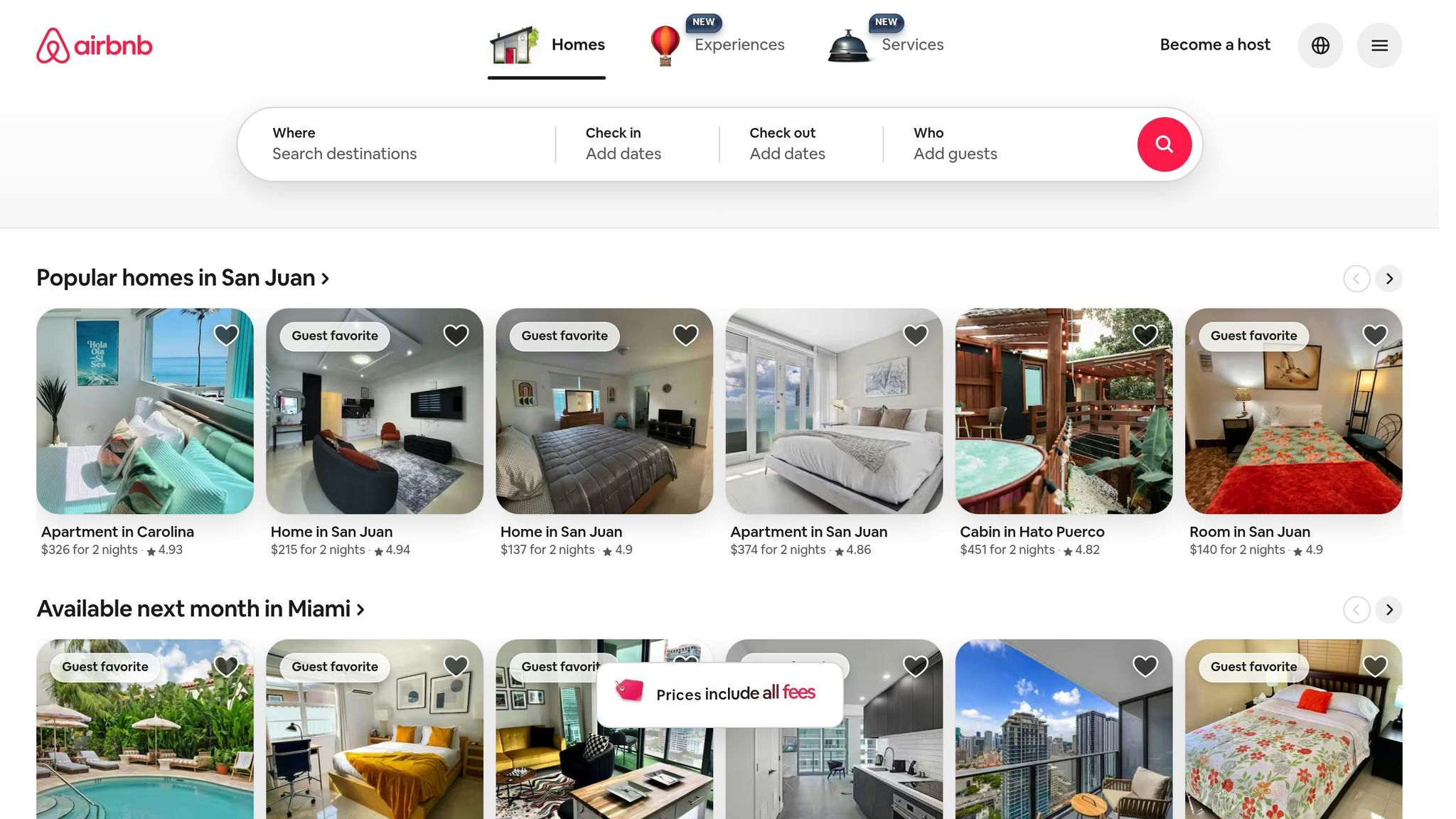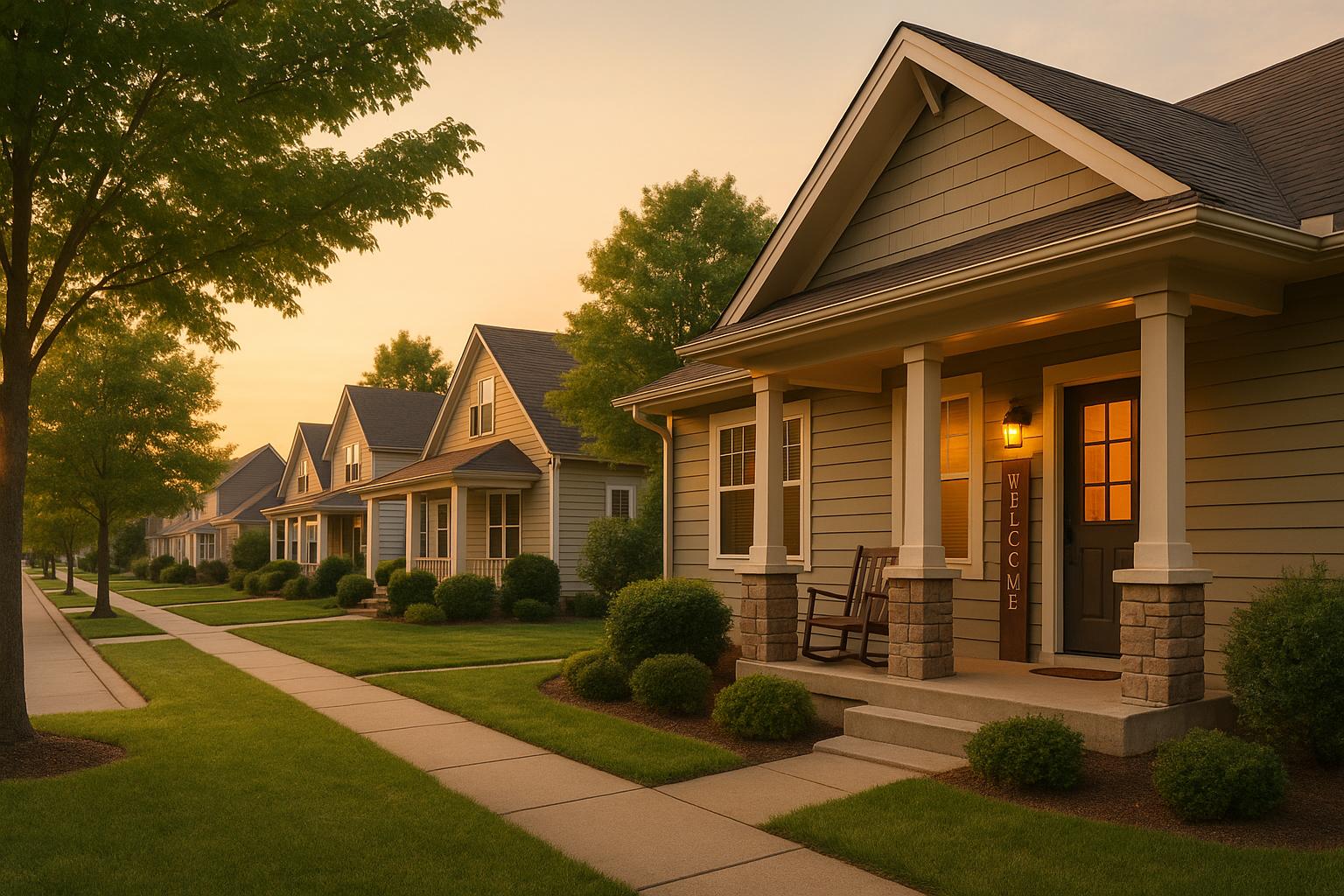The short-term rental market in Wake Forest, Morrisville, and Garner is thriving, thanks to the Triangle’s economic growth and changing travel preferences. Here’s a quick breakdown:
- Wake Forest: Known for its suburban charm, top neighborhoods include Historic Downtown, Heritage, and Wakefield. Average annual revenue is $31,181, with properties earning up to $55,581 for larger homes.
- Morrisville: A hub for business travelers near Research Triangle Park, top areas include Town Center, Tech Corridor, and Preston Village. Average daily rates are $123, but the market is competitive with a -26.2% revenue decline year-over-year.
- Garner: Affordable with small-town charm, key neighborhoods include Downtown Garner, Lake Benson, and South Garner. Median annual Airbnb revenue is $22,324, with October being the most profitable month.
Each town offers unique advantages based on guest demographics, amenities, and local attractions. Whether you’re targeting families, business professionals, or leisure travelers, understanding these neighborhoods’ strengths is essential for success. Below, we’ll dive deeper into the specifics of each area.
TOP 7 North Carolina Cities To Buy Airbnb Investment Properties

1. Wake Forest Top Neighborhoods
Wake Forest has become one of the most attractive short-term rental markets in the Triangle area, with properties earning an average annual revenue of $31,181 and maintaining a steady 46% occupancy rate. The town combines suburban charm with convenient access to major attractions, making it a favorite among travelers.
Historic Downtown Wake Forest is the top pick for short-term rental investments. Visitors flock to this area for its authentic Southern vibe, complete with historic architecture, boutique shops, and lively community events. Attractions like the Wake Forest Historical Museum, Joyner Park, and the ever-popular farmers’ markets keep demand high throughout the year. The walkable nature of downtown adds to its appeal, offering guests easy access to restaurants, cafes, and local festivals – all without needing a car. Beyond downtown, several neighborhoods cater to specific guest profiles, from families to luxury travelers.
For those targeting family-friendly rentals, the Heritage neighborhood is a strong contender. This modern, residential area is perfect for families and business travelers looking for a safe, quiet environment close to amenities. Events at Heritage High School, the Heritage Golf Club, and walking trails ensure consistent demand. The neighborhood’s upscale atmosphere, complete with community pools and fitness centers, allows property owners to charge premium rates.
If your focus is on luxury travelers, Wakefield is the neighborhood to watch. Centered around the Wakefield Plantation Golf Club, this area attracts guests who are willing to pay more for high-end accommodations. With its golf course, community events, and convenient shopping options, Wakefield is ideal for weekend getaways and corporate retreats. Homes with features like pools or spas perform particularly well here, commanding higher booking rates.
For a younger, activity-driven crowd, the Factory district is a hotspot. Anchored by The Factory at Franklin, this area offers a mix of restaurants, bowling, outdoor concerts, and shopping, making it appealing to younger travelers and groups. The abundance of entertainment options within walking distance makes this neighborhood a standout choice for those seeking a lively stay.
Outdoor enthusiasts will find their match in the Smith Creek and North Wake neighborhoods. Smith Creek offers scenic views and opportunities for wildlife spotting, while North Wake provides direct access to Falls Lake State Recreation Area. These areas see a surge in demand during the summer months as visitors look for hiking, fishing, and boating activities. Properties in these neighborhoods benefit significantly from their proximity to nature.
When it comes to revenue, returns vary widely depending on property size and type. Studio rentals bring in about $11,068 annually, while 4-bedroom homes can earn up to $55,581. Properties with 2–3 bedrooms cater to the core market of families and small groups, striking a balance between affordability and space.
Wake Forest’s seasonal trends also play a big role in revenue. May is typically the busiest month, and summer – spanning June through September – sees the highest occupancy rates as families take advantage of school vacations and outdoor activities. Rentals with outdoor amenities like fire pits, hot tubs, or gardens tend to perform exceptionally well during these peak months.
To maintain stability, compliance with local registration and safety regulations is essential. Additionally, the local real estate market remains balanced, with homes selling close to their asking price after an average of 38 days on the market. This stability makes Wake Forest an appealing option for investors entering the short-term rental space.
2. Morrisville Top Neighborhoods
Morrisville’s location near Research Triangle Park makes it a hotspot for business travelers, professionals, and families. Short-term rentals here typically bring in an average daily rate of $123, with a 40.1% occupancy rate.
Town Center is a favorite among investors aiming to attract both families and business travelers. Its proximity to Morrisville Community Park, The Shoppes at Kildaire, and the Koka Booth Amphitheatre makes it highly convenient. The neighborhood’s walkable greenways and diverse dining options add to its charm, with March often being the most lucrative month for rentals.
The Tech Corridor serves professionals visiting Research Triangle Park. With major employers nearby, the area sees consistent bookings from consultants and temporary workers. It also benefits from attractions like Cary Towne Center and Durham Bulls Athletic Park. Properties in this area often command higher rates, thanks to the affluent demographic – Morrisville’s median household income is $125,404.
For those drawn to nature, the area around Lake Crabtree County Park is a perfect fit. This neighborhood offers mountain biking trails, fishing spots, and boat rentals, making it a favorite for families and outdoor enthusiasts seeking a peaceful getaway close to urban conveniences.
McCrimmon Corners provides a well-rounded experience for tourists and business visitors alike. Its variety of dining options and shopping plazas make it particularly appealing for larger groups, especially those seeking accommodations for 8 or more guests.
The Preston Village neighborhood caters to visitors looking for upscale stays near Prestonwood Country Club. Its tranquil atmosphere and luxury amenities attract guests willing to pay premium rates, especially for properties with golf access or scenic views during peak seasons.
In Morrisville’s Airbnb market, private room listings dominate, accounting for 54.1% of the 37 active rentals, while houses – primarily 3-bedroom configurations – make up 86.5% of the market. The town’s lenient short-term rental regulations give property owners plenty of flexibility. For example, 25.7% of listings require a minimum stay of just three nights, and the average booking lead time is 33 days.
To maximize returns, understanding market trends is essential. While top-performing properties can command $226 or more per night, typical rentals average $111. However, the market has seen a -26.2% year-over-year revenue decline.
Most guests are domestic travelers (96%), often coming from nearby Raleigh. They expect essentials like air conditioning, WiFi, heating, TV, free parking, and washer access. Notably, about half of all bookings come from travelers born after 2000.
Morrisville’s reputation as a top place to live and its All-America City designation add to its appeal. As one of North Carolina’s fastest-growing communities, the town continues to attract demand for quality short-term rental options.
sbb-itb-f40617d
3. Garner Top Neighborhoods
Garner offers a blend of small-town charm and convenient access to city life, making it a prime spot for short-term rental investments. Just 10 minutes from downtown Raleigh and home to more than 35,000 residents, the town boasts strong rental market metrics, including a median annual Airbnb revenue of $22,324 and an 11.5% year-over-year growth rate.
Downtown Garner is a standout area for short-term rentals. Its historic district is packed with local charm, featuring boutique shops, cozy restaurants, and a true North Carolina vibe. The Garner Performing Arts Center (GPAC) is a cultural hub, hosting shows and events that attract visitors year-round. Guests can enjoy a leisurely stroll through the area, stopping by popular spots like Full Bloom Coffee, Craft Cafe, Shady’s Bar, and Aristotle Spirits.
For those seeking a more tranquil setting, Lake Benson is a popular neighborhood for nature enthusiasts. Lake Benson Park spans 64 acres, offering 1.8 miles of trails and opportunities for fishing and kayaking. October is a peak season for this area, with properties generating an average of $3,064 per month and occupancy rates of 59.3%. The peaceful lakeside atmosphere provides a relaxing escape while still being close to Raleigh.
In contrast, South Garner appeals to families and professionals, thanks to its growing residential vibe and proximity to major employers like the Amazon distribution warehouse, which opened in 2020. This steady demand makes it a reliable choice for rental investments.
White Deer Park combines outdoor activities with community-focused charm. The park offers scenic trails and is known for its annual Groundhog Day event featuring Mortimer, the town’s furry weather predictor. Families and outdoor lovers flock to this neighborhood, especially during the pleasant spring and fall months.
Across Garner’s neighborhoods, the short-term rental market shows strong performance. The average daily rate is $169, with an occupancy rate of 47.0%. High-performing properties can earn over $4,890 per month with occupancy rates exceeding 83% and nightly rates above $264. Meanwhile, typical rentals bring in around $2,404 per month at 50% occupancy and $143 per night.
Garner benefits from lenient short-term rental regulations, allowing for operational flexibility. Many properties feature three or more bedrooms and cater to groups of around six guests. October is a particularly lucrative month, as hosts use dynamic pricing tools to maximize revenue during this peak season.
The town’s guest demographics are largely domestic travelers from nearby cities like Raleigh and Charlotte. Younger travelers, especially those born after 2000, are increasingly booking stays, prompting hosts to offer modern amenities like high-speed Wi-Fi, air conditioning, TV, heating, and free parking.
Garner’s affordability further strengthens its appeal. Housing costs are 25% below the national average, and the overall cost of living is 8% lower. Ryan Fitzgerald of Raleigh Realty highlights the town’s appeal, stating, "The combination of location and affordability is unbeatable, so Garner is considered one of the best places to live in North Carolina".
With ongoing growth driven by employers like Amazon, Garner continues to see strong demand for quality short-term rentals across its diverse neighborhoods, making it a smart choice for investors.
Pros and Cons
After diving into the top neighborhoods of each town, it’s time to weigh the broader advantages and challenges they bring to the table. The Research Triangle towns each offer unique opportunities and hurdles for short-term rental investors. Breaking down these trade-offs helps fine-tune investment strategies.
Wake Forest is a standout for its upscale market and strong rental performance. With its rapid growth and reputation as the sixth-best place to live in North Carolina, demand from high-end guests remains steady. The town boasts 420 short-term rentals, generating monthly revenues between $1,401 and $2,091, indicating a healthy but not overly saturated market. However, the median home price of $655,040 can be a significant barrier. High property costs mean larger upfront investments and could lead to financial strain during periods of low occupancy.
Morrisville shines with its central location and appeal to corporate and relocating professionals. Its proximity to major employment hubs and the airport makes it a magnet for business travelers. However, there are only 158 short-term rentals in the area, which translates to tough competition. Additionally, homes here often come with smaller yards, and the cost of living is higher compared to other suburbs in the Triangle [39,41].
Garner stands out for its affordability. Housing costs are 25% below the national average, and the overall cost of living is 8% lower than typical U.S. markets. Compared to Wake Forest’s high entry costs and Morrisville’s competitive inventory, Garner offers an easier entry point for investors. However, its amenities lean heavily on nearby Raleigh, aside from local options like the White Oak shopping center. While Garner is affordable, its reliance on urban centers for broader amenities might require investors to cater to more budget-conscious guests.
Here’s a quick comparison of the key market factors across the three towns:
| Aspect | Wake Forest | Morrisville | Garner |
|---|---|---|---|
| Entry Cost | High ($655,040 median) | Moderate to High | Low (25% below national average) |
| Rental Potential | $1,401–$2,091/month | $1,329–$2,042/month | Not specified |
| Market Growth | Rapid growth | Fastest-growing in NC | Competitive |
| Guest Demographics | Premium leisure/family | Business/corporate | Domestic leisure travelers |
| Proximity to Attractions | Historic downtown, local charm | Airport, RTP, Triangle access | Lake activities, Raleigh access |
| Competition Level | Moderate (420 properties) | High (158 properties) | Growing but manageable |
Profit margins for short-term rentals often range between 25% and 50% of annual rental income, making the right location critical for maximizing returns. Maintenance costs, which tend to be higher than for long-term rentals, and seasonal demand fluctuations should also be part of an investor’s calculations [34,36].
While short-term rentals generally deliver higher daily revenue compared to long-term leases, they come with challenges like vacancy risks and off-peak income dips. Choosing the right neighborhood that aligns with your budget and management approach is key to success.
Conclusion
Wake Forest appeals to premium guests, Morrisville caters to business travelers with its convenient location near major hubs, and Garner provides a practical starting point for new investors entering the market.
But thriving in these areas requires more than just picking the right location. Providing top-notch service plays a huge role in boosting guest satisfaction and occupancy rates. Even small details can have a noticeable impact on profitability. When paired with supportive local policies, these efforts can significantly enhance rental performance.
Local regulations in these towns are particularly favorable, with features like low zoning permit fees and reasonable tax rates. Over the past two years, listings on platforms like Airbnb and VRBO in this region have grown by 81% – a clear sign of rising interest and opportunity.
For property owners who want to maximize their returns without the hassle of day-to-day management, NC Host Pro offers co-hosting services. Their fixed monthly fee covers essentials like guest communication, pricing strategies, and property maintenance, allowing owners to focus on the bigger picture.
Whether you’re drawn to the luxury appeal of Wake Forest, the business-friendly vibe of Morrisville, or the accessibility of Garner, each town presents a unique opportunity for success. By tailoring your investment strategy to the strengths of each location, you can tap into the growing potential of North Carolina’s short-term rental market.
FAQs
What should I look for in a neighborhood when investing in short-term rentals in Wake Forest, Morrisville, or Garner?
When deciding on a neighborhood for short-term rental investment in Wake Forest, Morrisville, or Garner, there are some key factors to keep in mind to make your property stand out and increase its earning potential. One of the most important considerations is proximity to attractions. Guests are often drawn to locations near parks, shopping hubs, and popular landmarks, so being close to these can give your property an edge. Likewise, neighborhoods with easy access to major highways or airports tend to attract more travelers, thanks to the added convenience.
Another crucial step is understanding the local regulations and zoning laws. Compliance is non-negotiable if you want to avoid fines or legal issues. Beyond that, neighborhoods with strong community features – like safe streets, quality schools, and plenty of dining and entertainment options – are more appealing to visitors, which can lead to better reviews and more bookings. Lastly, pay attention to the rental demand and market trends in the area. Choosing a neighborhood with steady demand can help ensure your property stays booked consistently.
What should property owners know about short-term rental regulations in Wake Forest, Morrisville, and Garner, and how might these rules impact their earnings?
Short-term rental rules in Wake Forest are fairly lenient, mainly focusing on licensing and safety standards. This makes it relatively simple for property owners to get started. On the other hand, Raleigh enforces stricter policies, such as a requirement that rentals must be at least 750 feet apart. This spacing rule can significantly reduce the number of eligible properties.
In towns like Morrisville and Garner, regulations are less defined, but the regional trend leans toward increased oversight. This could mean new licensing fees, occupancy limits, or additional restrictions in the future. These changes might lead to higher compliance costs or fewer rental opportunities, potentially impacting profitability. Property owners should keep a close eye on local regulations to stay compliant and protect their earnings.
How can property owners in Wake Forest, Morrisville, and Garner maximize their short-term rental income and occupancy?
Property owners in Wake Forest, Morrisville, and Garner can increase both income and occupancy by focusing on properties in high-demand areas. Look for neighborhoods close to popular attractions and major commuter routes. Proximity to shopping, dining, and recreational spots often draws more guests and boosts rental potential.
To remain competitive, consider adopting dynamic pricing strategies. Adjusting rates based on local market trends and seasonal demand ensures you’re maximizing revenue. At the same time, offering top-notch amenities – like fast Wi-Fi, cozy furnishings, and well-kept spaces – can elevate guest satisfaction and lead to repeat bookings.
It’s also essential to stay updated on local regulations and comply with short-term rental laws to avoid any legal complications that might disrupt your business. By carefully choosing properties, pricing strategically, and delivering outstanding guest experiences, property owners can thrive in these growing rental markets.

